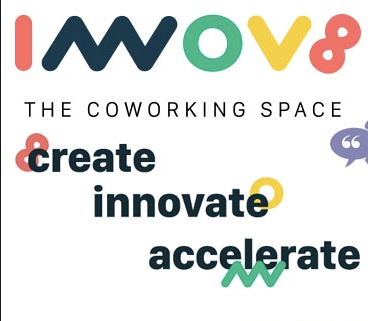Latest news about Bitcoin and all cryptocurrencies. Your daily crypto news habit.
 rMade by Rahul RandeA world famous designer and artist Karl Lagerfeld said “Logos and branding are so important. In a big part of the world, people cannot read French or English — but are great in remembering signs”.
rMade by Rahul RandeA world famous designer and artist Karl Lagerfeld said “Logos and branding are so important. In a big part of the world, people cannot read French or English — but are great in remembering signs”.
Once upon a time it wasn’t your job to distinguish your brand from others, it was people’s. Word of mouth and some quality offering, that was it!
But today, it’s more about how people connect with you through your distinct identity; how people will reach out for your product in the shelves of a departmental store, than your competitor’s.
This is what Rahul Pande focused on while creating the logo of Innov8. Innovative indeed!
Logos are crucial for the marketing success of your brand or company. It is easier for your customers to remember your identity if it’s together unique and memorable. Through your logo, you create a personality for your brand that will attract people and create personal relationships with them.
Here I have summed up a Design Flow used to create the innov8 logo:
1. Brainstorming
Start with the keywords that come to your mind when you think of the company or brand. Feel free to make your mind maps.
For example, to create the logo for innov8, Rahul Pande came up with these words — Accelerate, Community, Funding, Startups, Ups & Downs (Success & Failure), Incubation,etc. He then started sketching around these words and tried to represent them visually but as abstractly as he could.
2. Research
Conduct both User Research and Market Research well.
It is advisable to think about: Nature of the Product
Target Audience —
For innov8 the audience consisted mainly of upbeat youngsters who could relate with the cool logo.
Color Palette —
Rule: Most acceptable color by audience is Blue, according to studies. And most brand use just two colors in their logos!
There is a psychology behind colors, different in different parts of the world.
Red means bold and energetic.Black and white mean luxury, authority and elegance.Yellow is related to happiness, warmth, caution.
Typography —
Rule: Either have your own kind of font to make it distinct or experiment with basics like Serif and Sans-Serif.
Add a little bold and italics here and there and check which suits best. Try to avoid Comic Sans MS because that looks really amateur.
Use maximum two types of fonts otherwise the logo may seem too decorative.
Size and Scalability —
Depending on which company your logo entertains, you must decide the size and scalability.
For example: Social media and online marketing Apps need logos which are visible in small sizes. But always try to keep your logo basic enough so that it can be recognized when made really, REALLY small.
Effects —
Effects do seem cool but our objective is to attract, not distract the viewer. Too much bling will kill the vibe.
Timeless —
Find something that identifies what you stand for. Base your design on that. Your logo should be able to conquer the test of time, so that 30 years from now you still don’t feel the need to change it. It shouldn’t resemble any other company remotely otherwise customers may not trust you. Also, even if you do need to make some changes to the original logo, it should be minimal so that people still recognize you with it.
For example: Google changed their logo font from Serif to San Serif and eliminated the bevel effect, making it flat because they wanted to venture into industry of small screens (mobile).
Note: Try to avoid clichés because they don’t have a recall value. What’s the point of having an identity if no one remembers it?
3. Drafting
At this point you bring all those bubbles in your mind together to create a few designs. Sketch as much as you can! Ask people around you for honest opinions and incorporate their feedback.
Don’t let your client dictate you otherwise you will end up with a logo that they like but it will probably not work. Involve them in refining stage where you have 2 or 3 solid deigns.And: ITERATE, ITERATE, ITERATE!
4. Polish
Work on the small effects like, shading, gradation etc. It is unbelievable how a change of a few millimetres can bring harmony in the logo.
5. Testing
It is the most important step before you launch the logo in public. Visual perception and association of third parties with the logo helps to bring to our notice the much needed alterations.
Factors can be — age, gender, color associations of people, language, technological awareness, education etc.
6. Protection
The final step is to get trademark registration of the logo, symbol or the word being used in the logo.
Don’t forget the Golden Rules of Logo Making, says Rahul!Things that are not totally necessary must be removed.Don’t combine other logos to make your own logo; that is surely not original.Avoid intricate details.Your logo should be able to look good and recognizable in black and white.The logo should be easily describable.Most importantly, do NOT go for the online logo making software. It’s like purchasing a really expensive wine from all your saving and drinking it in a plastic cup.If an entrepreneur has already invested large amount of capital in the structure, management, marketing, and development, he should spend a little on the design language to stand out.
Hope this blog helps you with your Logo.
Our upcoming event
We thank Mr. Rahul Pande for his time and setting the great example of a logo as innov8!
Rahul Pande is a self-taught graphic designer having expertise as a Design Consultant at many firms including Adobe India.
Written by, Sakshi Kaul, a 20-year old writer who has a fascination for mountains, wine and biblichorded English classics and is a blogger at
Why Innov8’s Logo has Ups and Downs? Behind the scenes… was originally published in Hacker Noon on Medium, where people are continuing the conversation by highlighting and responding to this story.
Disclaimer
The views and opinions expressed in this article are solely those of the authors and do not reflect the views of Bitcoin Insider. Every investment and trading move involves risk - this is especially true for cryptocurrencies given their volatility. We strongly advise our readers to conduct their own research when making a decision.
